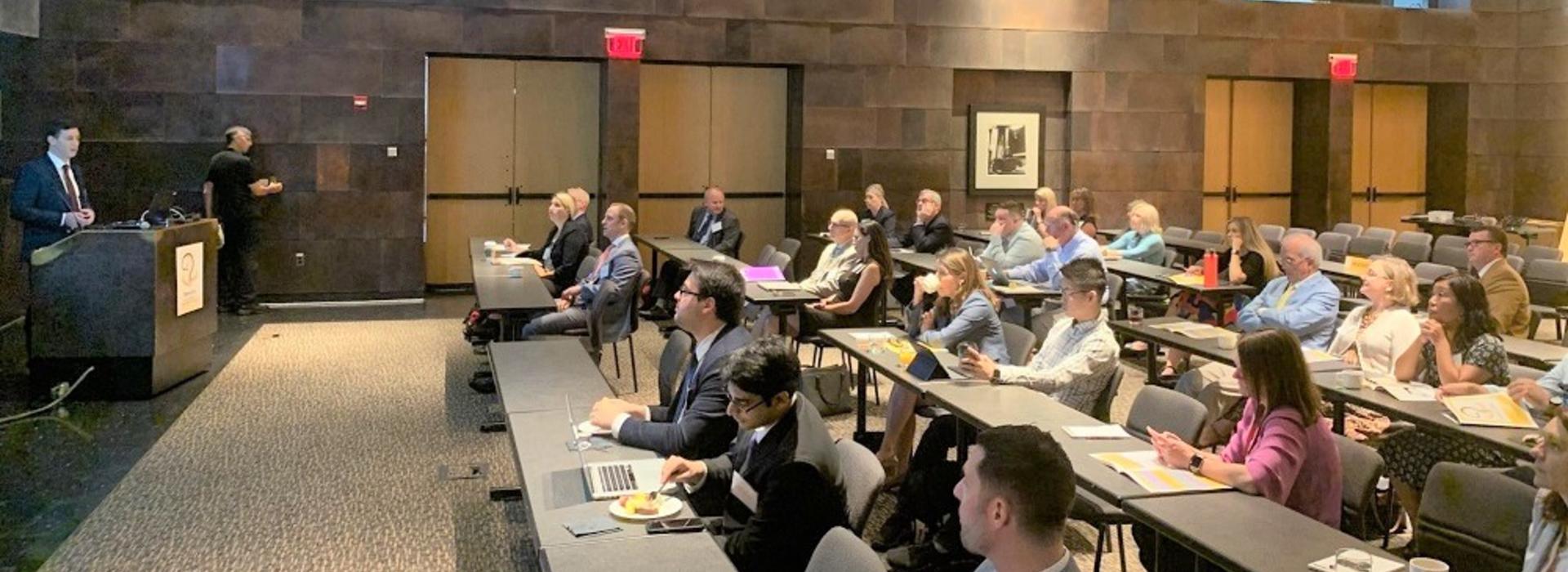
U of M’s NeuroSafe 2019 leaves attendees excited and looking forward to next year
NeuroSafe 2019, the fourth annual two-day national symposium dedicated to improving neurosurgical quality and safety, concluded on August 9 in U of M’s McNamara Alumni Center. This year’s event inspired one attendee from the University of Alabama at Birmingham Health System to write, “Excited to share the knowledge gained at Neurosafe 2019 with neurosurgery and quality and safety teams. Already looking forward to next year.”
The symposium was filled with nationally recognized keynote speakers and abstract presenters who are at the forefront of these important topics. “Thanks to everyone who spent the past two days thinking, sharing, and collaborating to improve quality and safety in neurosurgery,” said NeuroSafe Course Director Matthew Hunt, MD. “It was our most successful symposium yet and we’re already thinking about what can be even better during NeuroSafe 2020!”
Day 1 Keynotes
- Taking Neurosurgery Survival and Quality Best Practices from the Department to the Multi-Institutional Level, Oren N. Gottfried, MD, FAANS, Duke University
- The Revolution of Data in Neurosurgery, Lola Chambless, MD, FAANS, Vanderbilt University. “Whether the models have to be personalized for the physician is unknown,” Tweeted NeuroSafe 2019 Course Director Barb Daiker, RN, PhD, during Chambless’ presentation. “The initial study says, no.” Chambless Tweeted after her presentation: “Proud to give a keynote at U Minnesota today. Lots of great minds discussing quality at NeuroSafe 2019.”
- Utilizing Metrics and Benchmarking to Persuade for Neurosurgical Quality and Safety FTEs, Patricia D. Miller, MHSA, BLA, CMPE, University of Kansas
- Is There Any Rationale to the Timeout, Gregory R. Trost, MD, University of Wisconsin, Madison
- Implementation of Target-based Care and Implant Protocol: Challenges and Triumphs, Gerald A. Grant, MD, FACS, Stamford University. “Dr. Grant looked at [hydrocephalus] shunt placement infections to find solutions to decrease occurrence,” noted Daiker. “He reminded attendees that satisfaction measures may not align with care targets.”
In reaction to the presentations he sat in on, abstract presenter George R. Cybulski, MD, FACS, MBA, of Northwestern University in Chicago, IL, Tweeted, “Wonderful opportunity to learn from and interact with leaders committed to ensuring the highest quality and safest care of patients.”
Day 2 keynotes
- Quality Improvement and Value Driven Outcomes as Part of Resident Education, Randy L. Jensen, MD, PhD, University of Utah
- Surgeon-led Quality and Safety Projects in the Operating Room, Jeffrey S. Raskin, MD, MS, Indiana University. “Dr. Raskin pointed out that cost reduction cannot be the primary driver of analysis variation among procedures, except for closure,” wrote Daiker. “He suggested this is due to standardization.”
- A Clinician's Toolbox for Meaningful Quality Improvement: Ideas to Take Home from a Pediatric Neurosurgery Practice, Sandi K. Lam, MD, MBA, FACS, FAAP, FAANS, Texas Children’s Hospital, Houston. “Dr. Lam used a closed Facebook group and other low-cost methods to build support and learn what works,” Daiker noted. “She found that helping the team know what happens when protocols are not followed helps secure support.”
- Safe Transitions Pathway for Post Craniotomy Neurological Surgery Patients: High Value Care that Bypasses the Intensive Care Unit, Jacob S. Young, MD, MS, neurosurgery resident, University of California San Francisco.
Mini spine symposium
New this year was a mini spine symposium held on Day 2. Speakers included:
- U of M spinal neurosurgeon Kristen Jones, MD, whose topic was, Horseshoes and Hand Grenades: Complication Avoidance and Optimizing Risk Factors Before, During, and After Spine Surgery
- Chief of Spine Surgery from the U’s Orthopedic Surgery Department, David Polly, MD, discussed Sagittal Deformity, SI Joint, and Searching for the Source of Pain: How to be Sherlock in Spine Surgery. Polly noted during his presentation that, “If you don't look for the problem in your spine patient, you can't find it”
- Jennifer Kendall Thomas, DO, of HealthEast in St. Paul, MN, asked the audience, Is It Worth A Shot? She told NeuroSafe 2019 attendees that she would like to see studies that help her better understand when to use epidural injections for her spine patients.
Mini symposium speakers also discussed challenging spine cases submitted by the audience.
Supporting organizations
The NeuroSafe 2019 planning team expresses its profound gratitude to this year’s supporting organizations:
Grants
- Medtronic
Platinum Level
- Medtronic Restorative Therapies Group
Silver Level
- Nordson Medical - Bone Graft Delivery Devices
- Zimmer Bio met Spine
Bronze Level
- BD
- Boston Scientific
- DePuy Synthes
- Hitachi Healthcare
- Integra - Codman Specialty Surgical
- Orthofix
- Stryker
- Synerfuse.
Sponsored lunches:
- Day 1: Engineers are from Mars, Surgeons are from Venus: how do we work Together to Ensure Patient Safety and Performance for Global Medical Devices, John Pracyk, MD, PhD, MBA, and Erin Johnson, PhD, MBA, WW Vice President (Johnson & Johnson and DePuy Synthes Spine)
- Day 2: Threat and Error Management – Using Next Generation Aviation Safety Principles to Reduce Risk and Complexity in the Operating Room, Stephen Powell, MSc, DHA(c), Chief Executive Officer (Synensis).
Congratulations to everyone associated with planning and implementing NeuroSafe 2019. Special thanks to the Course Directors (all from the University of Minnesota):
- Matthew Hunt, MD
- Daniel Guillaume, MD, MS
- Kristen Jones, MD
- Barbara Daiker, RN, PhD.
Be sure and mark your calendars for NeuroSafe 2020, July 23-24.
Links to all keynote and abstract presentations (scroll down and look for the 2019 Presentations tab).



